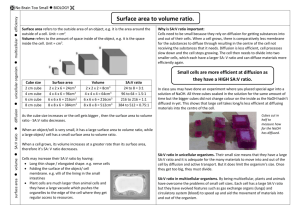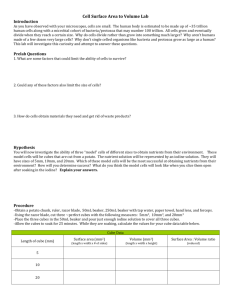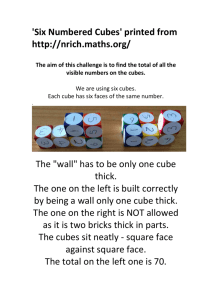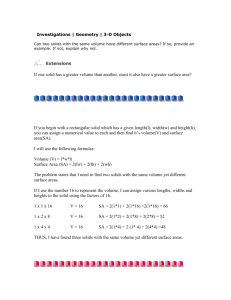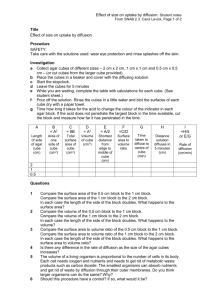Lesson 15d Limitation of Cell Size LP 2
advertisement
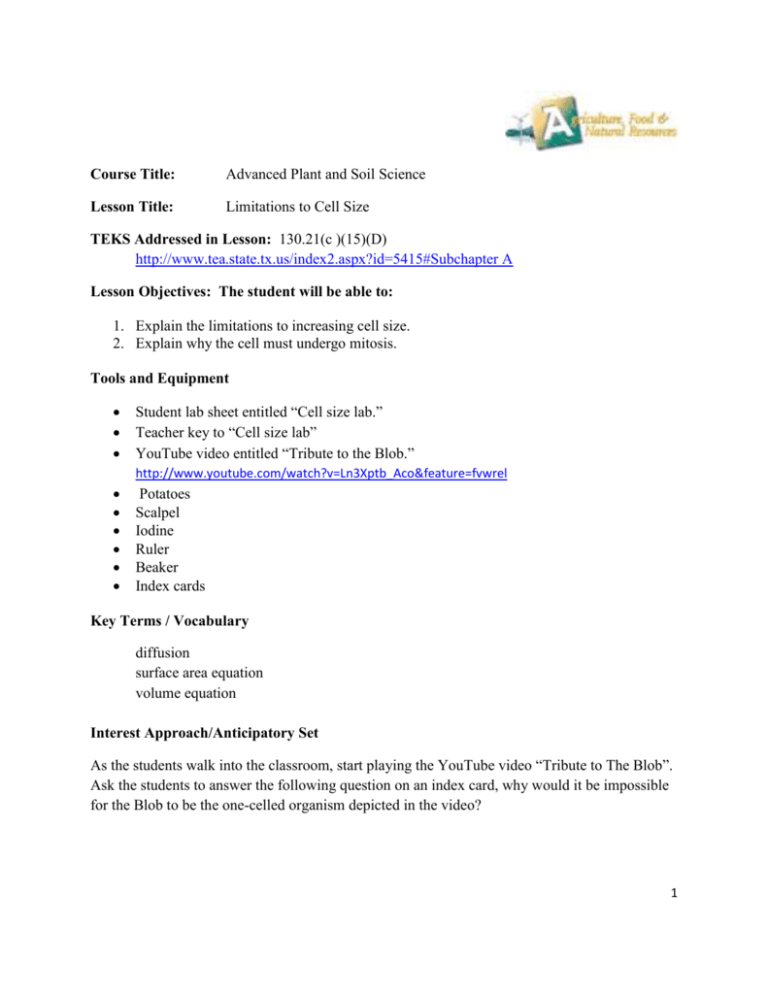
Course Title: Advanced Plant and Soil Science Lesson Title: Limitations to Cell Size TEKS Addressed in Lesson: 130.21(c )(15)(D) http://www.tea.state.tx.us/index2.aspx?id=5415#Subchapter A Lesson Objectives: The student will be able to: 1. Explain the limitations to increasing cell size. 2. Explain why the cell must undergo mitosis. Tools and Equipment Student lab sheet entitled “Cell size lab.” Teacher key to “Cell size lab” YouTube video entitled “Tribute to the Blob.” http://www.youtube.com/watch?v=Ln3Xptb_Aco&feature=fvwrel Potatoes Scalpel Iodine Ruler Beaker Index cards Key Terms / Vocabulary diffusion surface area equation volume equation Interest Approach/Anticipatory Set As the students walk into the classroom, start playing the YouTube video “Tribute to The Blob”. Ask the students to answer the following question on an index card, why would it be impossible for the Blob to be the one-celled organism depicted in the video? 1 Teaching Plan and Strategy / Presentation of New Material Discuss the introduction of the lab entitled “Cell Size” emphasizing the limitations of the increase of cell size. Activity/Application/ Student Engagement /Laboratory Assign the students the lab exercise entitled “Cell size.” Evaluation / Summary The exit ticket is to revisit the question on the index card answered at the beginning of class. Change or add to their answer to include what they learned from the lab. References/Additional Materials / Extended Learning Opportunities/ Enrichment: Postlethwait, John H. and Hopson, Janet L., et al. Modern Biology. 2nd ed. Austin, Tx: Holt, Rinehart and Winston, 2009. Campbell, Neil A., Reece, Jane B. and Mitchell, Lawrence G., et al Biology. 9th ed. Menlo Park, CA: Pearson, Benjamin Cummings, 2010 College & Career Readiness Standard Science VI A4 & D 5 ©Texas Education Agency, 2013 2 Cell Size Lab Introduction: Cells come in a variety of sizes. Some red blood cells are only 8 µm in diameter. Nerve cells can reach lengths up to 1 meter. Most living cells, however, are between 2 and 200 µm in diameter. Why can’t organisms be just one giant cell? 1. Diffusion limits cell size: cells require a constant supply of glucose and oxygen to carry out ______ _______ and to produce large amounts of __ _____________. These substances, and waste products such as carbon dioxide, move through the cytoplasm by diffusion. It has been estimated that it takes a molecule of oxygen only a fraction of a second to diffuse through the cytoplasm from the plasma membrane to the center of a typical cell that is 20 µm. What would happen if the cell got bigger? Although diffusion is efficient over short distances, it becomes slow and inefficient as the distance becomes larger. Hypothetically, a cell with a diameter of 20 cm would have to wait months before receiving molecules that enter the cell. Because of this time restriction the cell/organisms would die if they were one large cell. 2. A cells DNA limits size: The second reason why cells are small is because they usually only contain one nucleus. If a cell doesn’t have enough DNA to program its metabolism, it cannot live. When a cell is larger it requires more enzymes and parts to function correctly, therefore it needs more instruction. In many large cells there are more than one nuclei to ensure that all cell activities will be carried out quickly. 3. Surface area-to-volume ratio: The third reason why cells are limited in size is that as a cell’s size increases, its volume increases much faster than its surface area. Note: Surface area = length of a side X width of a side X number of sides Volume = length X width X height Surface area to volume ratio = surface area / volume 3 The smallest cell has a volume of 1mm3 and a surface area of 6mm2. If the side of the cell is doubled to 2 mm, the surface area will increase fourfold. Calculate what happens when the cell side is 4mm. Volume _________________________ Surface area _____________________. If cell size is doubled, the cell would require eight times more nutrients and would have eight times more waste to excrete. The surface area would only increase by a factor of 4. Therefore, the plasma membrane would not to have enough surface area through which oxygen, nutrients, and waste could diffuse. The cell would either starve to death or be poisoned by the build p of waste products. Objective: In this lab, the diffusion rate of iodine will be observed through 4 potato cubes of different size. The cubes contain starch which turns purple when it comes in contact with iodine. Iodine will slowly diffuse into the agar cubes and change its color from white to purple. Safety: Chemical safety: Iodine can be an irritant, and it stains skin and clothes. Material: Potatoes Scalpel Iodine Ruler Beaker Hypothesis: How does size of the cubes (cells) affect the diffusion? Procedure: 1. Obtain potatoes from your instructor. Using a knife cut the potatoes into cubes following the given measurements below. Plan out your cuts ahead of time, it is suggested that you cut out the large cube first. Only one piece of large potato will be given to your group. Block A: Block B: Block C: Block D: 0.5 cm sides 1.0 cm sides 2.0 cm sides 3.0 cm sides 2. Return any reusable pieces to instructor and discard remaining pieces. 3. Calculate the surface area for each cube and record the answer in table 1. 4 Surface area = length of a side X width of a side X number of sides Calculate the volume of each cube and record the answer in table 1. Volume = length X width X height Find and record the surface area to volume ratio for each cube in table 1. Surface area to volume ratio = surface area / volume 4. Place all four cubes in the bottom of a beaker so that they do not touch each other or in the sides of the beaker. 5. Pour in enough iodine to cover all four cubes. Allow 20 minutes for the diffusion process; GENTLY stir solution so that diffusion takes place evenly over each cube. 6. Remove the blocks from solutions, place on paper towel and slice each cube in half. 7. Quickly measure to the nearest 0.1 cm across the area with no iodine on each cube (clear area) 8. Calculate the surface area, volume, and surface area to volume ratio for the portion of the cube with no iodine (clear cube) and record it in table 2. Table 1: Cube Side length (cm) A .5 B 1.0 C 2.0 D 3.0 Surface area (cm2) Volume (cm3) Surface area to volume ratio (surface area : volume) 54 27 2:1 5 Table 2: Cube !Portion of the cube without iodine! Original side length of cube (cm) Surface area (cm2) Volume (cm3) (see above) Volume diffused into the cube (volume of original cube minus the volume of the middle cube) A B C D Questions: 1. What solution is being diffused into the potato block? 2. Rank the cubes from the largest surface area to volume ratio to the smallest surface area to volume ratio. . 3. Why are cells relatively small in size? List at least three reasons 4. All of the cells below have approximately the same volume. Calculate the surface area for all cubes. Then, circle the letter of the one with the largest surface area. A. 6 B. C. 5. How would heating the solution affect the results in this lab? Conclusion: What cell process would correct the limitations to cell size? Support your hypothesis. 7 Cell Size Lab Teacher Key Introduction: Cells come in a variety of sizes. Some red blood cells are only 8 µm in diameter. Nerve cells can reach lengths up to 1 meter. Most living cells, however, are between 2 and 200 µm in diameter. Why can’t organisms be just one giant cell? 1. Diffusion limits cell size: cells require a constant supply of glucose and oxygen to carry out ______respiration_______ and to produce large amounts of __ATP_____________. These substances, and waste products such as carbon dioxide, move through the cytoplasm by diffusion. It has been estimated that it takes a molecule of oxygen only a fraction of a second to diffuse through the cytoplasm from the plasma membrane to the center of a typical cell that is 20 µm. What would happen if the cell got bigger? Although diffusion is efficient over short distances, it becomes slow and inefficient as the distance becomes larger. Hypothetically, a cell with a diameter of 20 cm would have to wait months before receiving molecules that enter the cell. Because of this time restriction the cell/organisms would die if they were one large cell. 2. A cell’s DNA limits size: The second reason why cells are small is because they usually only contain one nucleus. If a cell doesn’t have enough DNA to program its metabolism, it cannot live. When a cell is larger it requires more enzymes and parts to function correctly, therefore it needs more instruction. In many large cells there are more than one nuclei to ensure that all cell activities will be carried out quickly. 3. Surface area-to-volume ratio: The third reason why cells are limited in size is that as a cell’s size increases, its volume increases much faster than its surface area. Note: Surface area = length of a side X width of a side X number of sides Volume = length X width X height Surface area to volume ratio = surface area / volume 8 The smallest cell has a volume of 1mm3 and a surface area of 6mm2. If the side of the cell is doubled to 2 mm, the surface area will increase fourfold. Calculate what happens when the cell side is 4 mm. Volume ______64cm3___________________ Surface area _____96cm2________________. If cell size is doubled, the cell would require eight times more nutrients and would have eight times more waste to excrete. The surface area would only increase by a factor of 4. Therefore, the plasma membrane would not to have enough surface area through which oxygen, nutrients, and waste could diffuse. The cell would either starve to death or be poisoned by the build p of waste products. Objective: In this lab, the diffusion rate of iodine will be observed through 4 potato cubes of different size. The cubes contain starch which turns purple when it comes in contact with iodine. Iodine will slowly diffuse into the agar cubes and change its color from white to purple. Safety: Chemical safety: Iodine can be an irritant, and it stains skin and clothes. Material: Potatoes Scalpel Iodine Ruler Beaker Hypothesis: How does size of the cubes (cells) affect the diffusion? Procedure: 1. Obtain potatoes from your instructor. Using a knife cut the potatoes into cubes following the given measurements below. Plan out your cuts ahead of time, it is suggested that you cut out the large cube first. Only one piece of large potato will be given to your group. Block A: Block B: Block C: Block D: 0.5 cm sides 1.0 cm sides 2.0 cm sides 3.0 cm sides 2. Return any reusable pieces to instructor and discard remaining pieces. 3. Calculate the surface area for each cube and record the answer in table 1. Surface area = length of a side X width of a side X number of sides 9 Calculate the volume of each cube and record the answer in table 1. Volume = length X width X height Find and record the surface area to volume ratio for each cube in table 1. Surface area to volume ratio = surface area / volume 4. 5. 6. 7. Place all four cubes in the bottom of a beaker so that they do not touch each other or in the sides of the beaker. Pour in enough iodine to cover all four cubes. Allow 20 minutes for the diffusion process. GENTLY stir the solution so that diffusion can take place evenly over each cube. Remove the blocks from the solutions, , place on a paper towel and slice each cube in half. Quickly measure to the nearest 0.1 cm across the area with no iodine on each cube (clear area) Calculate the surface are, volume, and surface area to volume ratio for the portion of the cube with no iodine (clear cube) and record it in table 2. Table 1: Cube Side length (cm) Surface area (cm2) Volume (cm3) A .5 1.5 .125 Surface area to volume ratio (surface area : volume) 12:1 B 1.0 6.0 1 6:1 C 2.0 24 8 3:1 D 3.0 54 27 2:1 10 Table 2 !Portion of the cube without iodine! Cube Original side length of cube (cm) (see above) .5 A B 1.0 C 2.0 D 3.0 Surface area (cm2) Volume (cm3) Volume diffused into the cube (volume of original cube minus the volume of the middle cube) varies Questions: 8. What solution is being diffused into the potato block? iodine 9. Rank the cubes from the largest surface area to volume ratio to the smallest surface area to volume ratio. .5, 1, 2, 3 10. Why are cells relatively small in size? List at least three reasons Can’t get the nutrients diffused fast enough, waste builds up, it can’t diffuse out fast enough and the DNA can’t produce enough proteins 11. All of the cells below have approximately the same volume. Calculate the surface area for all cubes. Then, circle the letter of the one with the largest surface area. *A. 11 B. C. 12. How would heating the solution affect the results in this lab? Speed up diffusion Conclusion: What cell process would correct the limitations to cell size? And support your hypothesis. Mitosis 12

